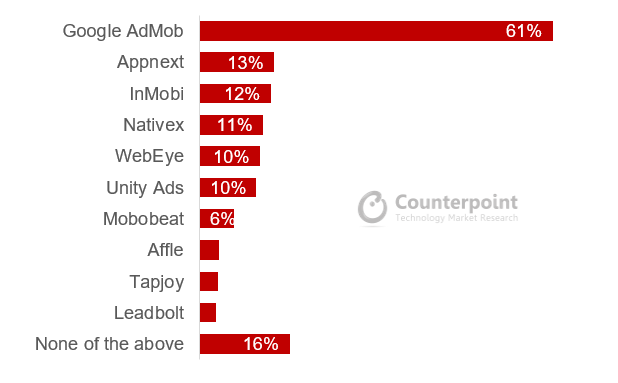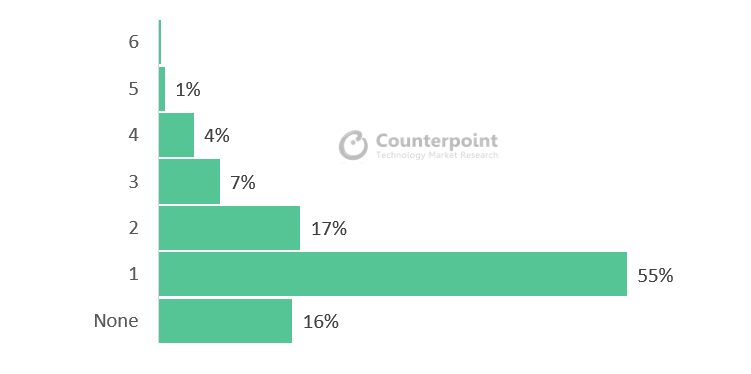- More than 60% of the app developers are using Google AdMob for mobile advertisements in India. Appnext and InMobi follow with second and third positions, respectively.
- More than half the mobile app developers have tried to monetize app data in India, others are interested to try it in the future.
Google AdMob is the most popular mobile advertising platform in the world’s second-largest smartphone and the largest Android market, India, according to Counterpoint Research’s recent Consumer Lens study. Among app developers who use advertising as a main source of revenue, more than 60% are using Google AdMob. Appnext and InMobi are neck-and-neck, in the second and third positions, respectively.
Commenting on the mobile advertising platforms – capabilities and competitive landscape, Senior Analyst, Pavel Naiya, said, “The existing Android developer ecosystem is a huge added advantage for Google. Additionally, easier integration and better monetization are two main factors where AdMob is leading over the others. Other important factors like security features, fraud detection, better reach, multiple ad format support, and affiliated revenue sharing make Google AdMob more attractive to mobile app developers.”
Naiya further added “InMobi fared well among the top two major factors for developers choosing this platform – monetization and ease of integration. While developers who chose Appnext highlighted the ease of integration, wider reach, and attractive affiliated revenue as some of the key reasons for adoption. Advertising analytics metrics are standard across all major ad platforms and therefore it has the least effect on developers’ decision-making process while choosing a mobile ads platform.”
Most Popular Mobile Advertising Platforms in India

In the current circumstances, COVID-19 is still spreading rapidly. To break the chain of transmission, many countries including India, are under lockdown. It has redefined businesses, work-culture, and personal dependency on digital tools for communication and content consumption. For many people, work-from-home is the new norm and they are embracing the digital medium to communicate with their coworkers.
It is an unexpected but welcome opportunity for businesses to become digital-first. It has also accelerated the adoption of digital platforms among urban and rural consumers. Consumers who have not connected earlier to digital commerce are trying to learn this new skill to survive. For example, private tutors living in a semi-urban India, who have never used a digital platform for teaching, are now using social media chat platforms to teach and distribute study materials. Many “Kirana” (mom-pop style grocery vendors) shopkeepers who always followed traditional cash transactions have started using digital commerce as a part of the day to day activities.
Commenting on this Arushi Chawla, Research Associate, said, “Despite being the second-largest smartphone market globally, India is still an underpenetrated internet market. Only less than half of the addressable population which is capable of using a mobile phone owns a smartphone. Further, India’s diverse cultures, languages, and high price-sensitivity have led to a digital divide and complex challenge for any app business to scale rapidly. The success of a new app depends on its new unique offerings and building trust through a continuous awareness program, which requires investment. As a result, most of the common app categories are though overcrowded but dominated by a few established players catering to the current smartphone user base.
However, the COVID-19 situation is a shot-in-the-arm to catalyze the digital transformation across the board presenting a broader opportunity for the mobile app developer ecosystem in India. To cater to this growing wave of digital adoption across consumer and businesses which were never connected presents a huge monetization opportunity for the app developers. The ad-supported freemium model would be the most attractive strategy for the app developers to monetize this expanding addressable market.”
The study further provides tons of insights into the current circumstances of app monetization scenarios, key challenges, and different business strategies. Some of the key findings include:
- Most of the apps are free in India and hence, app developers rely on advertising as a major source of revenue. About 84% of the app developers have used one or more advertising platforms. And among these, about 30% have used more than one mobile advertising platform in the past two years. This means the market is still not a zero-sum game and offers a multitude of opportunities for different ad-platforms to prudently strategize, differentiate, and find their sweet spot. Facebook has recently announced an investment in Jio Platforms Limited that opens up the possibility of the emergence of a new mobile advertisement platform serving ads to users beyond its app ecosystem and reaching close to 400 million Jio users.
Number of Advertisement Platform Used in The Last Two Years

- More than half the mobile app developers have tried to monetize app data. Among developers who have not tried to monetize app data in the past, almost half of them are interested in doing so in the future.
- Working as an “outsourced app development partner” for other companies is another major source of revenue for app developers in India.
- Smartphone OEMs are playing an important role as a medium for app developers to capture or maintain customer base through the pre-installation of apps.
- Developers use OEM-level deeply integrated app customization or optimization to provide a better user experience. Almost half the app developers have worked with smartphone OEMs in the last two years to create deeper integration in their apps, according to the research.























